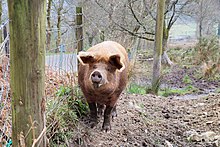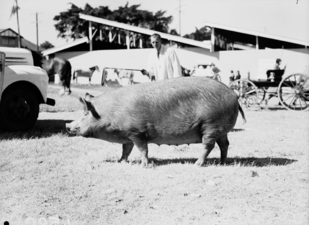Tamworth pig
Appearance
This article needs additional citations for verification. (January 2022) |
| Country of origin | United Kingdom |
|---|---|
| Standard | |
| Traits | |
| Weight | |
| Skin colour | flesh-colour |
| Hair | red-gold |
The Tamworth is a British
domestic pig. It is the only red-coloured British pig.[4]: 700 Its origins are unknown, but it appears to have developed near the town of Tamworth in south-eastern Staffordshire, close to Warwickshire border.[4]: 700 It is one of seven British pig breeds listed by the Rare Breeds Survival Trust as 'priority', the highest level of concern of the trust.[5]
History

The origins of the Tamworth are not known. It appears to have originated shortly before or after 1800 near the town of
Sir Robert Peel;[6] that Peel had not used these, but a boar brought from the West Indies; or that the colour was due to a West African Guinea Hog descended from pigs from Portugal, or to a red pig imported in about 1750 from Barbados.[4]: 700 The colour may have been fixed by selective breeding alone.[4]
: 700
The Tamworth was recognised as a breed in 1865 and entered at the
breed society, the Tamworth Incorporated Pig Breeders Association, was formed in 1906.[4]
: 700
Tamworths were imported into the United States by Thomas Bennett of
USA, and Canada. Farmers in each country much favour other pigs in quantity. From 1913 to mid-century, the breed reached peak numbers in Canada, reaching up to 10% of total swine. In Australia, the breed reached peak numbers of about 1000 in the mid-20th century.[8] In New Zealand there were five breeding sows in 2002; in 2021 it was listed as "priority" by the Rare Breeds Conservation Society of New Zealand.[9]
Characteristics

The Tamworth has a long snout, a slightly dished or concave profile, and prick ears.[10] The coat is long, fine and straight and of a ginger or red-gold colour, preferably without black hair; the skin is flesh-coloured and should carry no black spots.[10]
Tamworths are considered a medium-sized porcine breed; a full-grown
Litter sizes are typically somewhat smaller than those of commercial breeds. Unacceptable features, according to breed aficionados, are: curly hair, a coarse mane
, a turned-up nose, and dark spots on the coat.
Gallery
-
At Mudchute Park and Farm on the Isle of Dogs
-
Champion sow in Queensland, 1950s
-
Sow, best of breed atThe Last Royal Show, 2009
See also
References
- ISBN 9789251057629. Archived 23 June 2020.
- ^ Breed data sheet: Tamworth / United Kingdom of Great Britain and Northern Ireland (Pig). Domestic Animal Diversity Information System of the Food and Agriculture Organization of the United Nations. Accessed February 2023.
- ^ a b Tamworth. Kenilworth, Warwickshire: Rare Breeds Survival Trust. Accessed February 2023.
- ^ ISBN 9781780647944.
- ^ Watchlist 2022–23. Kenilworth, Warwickshire: Rare Breeds Survival Trust. Archived 28 September 2022.
- ^ Tamworth Pig. Canadian Farm Animal Genetic Resources Foundation. Archived 17 January 2015.
- ^ Breed Information – ALBC Conservation Priority List. American Livestock Breeds Conservancy. Archived 29 July 2012.
- ^ Australian Agriculture 1993, National Farmers Federation, Morescope Publishing (1993)
- ^ Tamworth Pigs: A Rare Breed of British Origin. Rare Breeds Conservation Society of New Zealand. Archived 20 April 2021.
- ^ a b The Tamworth. The British Pig Association. Archived 1 August 2017.
- ^ Aberdeenshire coastal countryside, Lumina technologies, Aberdeen Library Archives, July 2006
Further reading
Wikimedia Commons has media related to Tamworth pig.
- James AS Watson and James A More, Agriculture: the science and practice of British farming, 4th ed. revised and enlarged, Edinburgh, Oliver and Boyd (1937)
- Annette and Grant McFarlane, Pig keeping on a small scale, Kenthurst, NSW, Kangaroo Press (1996).
- J van Der Pol.., Today’s hog won’t work outdoors, Graze. (reproduced in Genesis vol.16, No.3, 2001)



